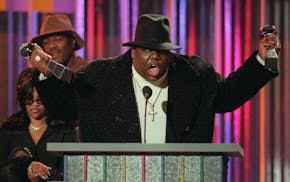Deangelo Curtis measured his life's work in kilos and ounces, and the year he turned 27, the scales were turning in his favor. The young St. Paul gangster sat atop a multimillion-dollar heroin boom sweeping Minnesota — the point man for an international drug cartel that linked the poppy fields of Mexico with the streets of the Twin Cities.
He called himself "King Kong."
To the agents watching from the shadows, Curtis was also a case study in the economics of Minnesota's new heroin trade: A highly structured trafficking operation that has spawned a new market of middle-class suburban users and delivers a product so pure that young Minnesotans are willing to risk their lives for the high of it.
Today, the wreckage can be seen across the Twin Cities — from the Anoka County gathering where parents told stories of death and addiction, to the Scott County courthouse, where a 20-year-old addict, pregnant with her first child, was sentenced to jail this month. The number of heroin deaths in the Twin Cities has tripled since 2011, to 63 last year. Hospital emergency rooms recorded 3,500 visits from panicked heroin users in 2011, and prosecutors say court dockets are crowded with heroin possession cases.
"What you are seeing is a Mexican cartel … creating a business model that is ingenious and cornering the market on what is now an epidemic," said Dan Moren, head of Minnesota operations for the U.S. Drug Enforcement Administration (DEA).
By marketing heroin for as little as $10 a dose, in a powder form that users can snort or smoke rather than inject, the cartels have developed an entirely new market of users who might once have been frightened off by the drug's sordid reputation. At the same time, these customers have built up little tolerance for heroin's devastating power, resulting in a rash of deaths by overdose.
Curtis was arrested in 2012 and sentenced to prison last year. Federal narcotics agents say he symbolized the breadth of a drug cartel that has created addicts from Vermont to California — but they also note that he was replaced instantly, one small player in a vast organization, so that his arrest scarcely disrupted the flow of high-quality, low-cost heroin into the Twin Cities.
"You're not going to 'jail' this problem away," said Phil Prokopowicz, a veteran Dakota County prosecutor who has seen heroin cases become a weekly norm in his office. "This is a supply and demand equation in the distribution of poison."
The new heroin boom has its roots in a successful anti-drug campaign that, starting seven or eight years ago, began to restrict the availability of popular prescription opiates such as oxycodone. The Sinaloa cartel, Mexico's largest and most feared smuggling federation, saw an opportunity and filled the gap. Mexico's heroin production has doubled since 2005, according to the U.S. Justice Department, and Mexico now ranks No. 2 in the world behind Afghanistan in poppy production.
By 2011, federal drug analysts estimated that at least four of Mexico's seven major Mexican trafficking organizations had wholesale distribution networks in Minneapolis-St. Paul. The dominant player was Sinaloa.
The cartel took a hit last month when its elusive co-leader, "El Chapo" Guzman, was finally arrested in a Mexican-U.S. sting. But narcotics agents say that a multibillion-dollar empire with an international distribution infrastructure is not going to be toppled by the capture of one of its czars.
By the time heroin reaches a young user in the Twin Cities, it will have been smuggled by wholesalers who operate with the efficiency of a FedEx logistical team and distributed by a retail operation as nimble as any pizza chain.
When agents in Minnesota look at a map of the United States, they don't dwell on state borders. Instead, they try to see the country much the way a cartel leader would: corridors of opportunity and spheres of influence.
All along the U.S.-Mexico border, investigators say, cartels compete for gateways that lead to regional trade monopolies. DEA sources say the Sinaloa cartel controls the border in much of Arizona and California, dividing it into "plazas" that are operated by area gatekeepers. More than 80 percent of the heroin, cocaine and methamphetamine reaching Chicago, for example, is now controlled by the cartel, according to the DEA.
Once packages cross the border, the cartel's mega-wholesalers in hub cities of the southwest — Tucson, Phoenix, Los Angeles — arrange to move them by semitrailer truck, car or bus. If a load is destined for Chicago, it is targeted for two predominant gangs — the Gangster Disciples and the Latin Kings, according to federal drug agents.
Along the way, the drugs are stored to evade detection by agents or drug-sniffing dogs. Ground coffee and axle grease are tough on a canine nose. An agent can search for hours trying to find the hidden switch that will pop open a truck bumper backfilled with bricks of powder.
Trade territories
From Chicago, heroin is distributed to the Twin Cities mainly by the Latin Kings and Gangster Disciples street gangs, whose couriers often ride inexpensive intercity buses, their stash hidden in X-box consoles or other innocuous parcels.
On reaching the Twin Cities, the smuggling pipeline forks. Most of the heroin packaged in powder form — intended for users who will snort it or smoke it — ends up on the North Side of Minneapolis, sold by Chicago's Gangster Disciples to their counterparts and gang subsets here. Suburban youth drawn from outlying Hennepin and Anoka Counties are the gang's primary customer base, agents say.
On the city's South Side and in St. Paul, Mexican distributors control sales through the Latin Kings. Agents say it's as if an invisible trading border has been drawn across Minneapolis, dividing north from south, and a private understanding divides the trade territories between Hispanic and African-American gangs.
At the street level, a drug retailer lives in a world of ounces, a user in the realm of grams. A kilo of heroin contains about 32 ounces, or 1,000 grams; a gram can be cut up into about 10 "highs" for retail sale. For that little packet, on today's market, a heroin user pays $10 to $20 to get a deep, opiate high that lasts hours.
That user, prosecutors say, could be a young adult from Eden Prairie, Brooklyn Park or Shakopee who dials up a retailer and waits for a one-gram order to be delivered, within an hour, to a shopping mall parking lot or fast-food drive-through. Agents describe it as a "call and drop" delivery tactic that rivals any takeout pizza chain for prompt service.
"It's not the inner-city alley where somebody is shooting up with a needle in their arm," said Prokopowicz, the Dakota County prosecutor. "It's now the teen from Hastings, the mom from Hastings and the successful businessman. We see this — the single mother with two or three kids present when there's a raid in their suburban home and she's arrested for possession or sale."
'King Kong'
By 2011, Deangelo Curtis was working on the high wire of this network. In early 2012 he was visiting Chicago personally, buying heroin at a purity rate of more than 90 percent, according to wiretap transcripts and federal court records. Curtis was so trusted by his Chicago connections inside the Latin Kings that he was fronted large amounts of heroin, his wholesalers trusting they would be repaid after he made his own profits.
A key to his success was his ability to bridge rival gangs. Through personal charm and connections made in prison or jail, agents say, Curtis was able to cross turf boundaries that are typically governed by race and gang affiliations. He was a black man accepted as a member of the Hispanic Latin Kings, and at the same time he could negotiate his way through the African-American Gangster Disciples' network in the Twin Cities.
"They called him King Kong for a reason," said the former DEA task force officer who conducted surveillance on Curtis. "You don't get to call yourself that unless you've got something to back it up."
After the 2012 bust that netted Curtis and his group, agents reviewed the cellphone of one of Curtis' Chicago associates. They found images of Curtis celebrating at a Homewood Hotel Suites room in Bloomington — posing with an automatic rifle in one photo, chewing down on a thick wad of cash while flashing the Latin Kings gang sign in another.
By 2013, Curtis and 42 other conspirators were facing prison, indicted after a two-year federal investigation. Besides seizing heroin, large amounts of cash and guns in Chicago, border agents intercepted 1,670 pounds of marijuana that was destined for the group.
Today, Curtis is serving six years at a federal prison in Terre Haute, Ind.
Cheaper than methadone
Jennifer Griffith is standing in a Scott County courtroom for sentencing on a probation violation. She is 20 years old, 9 months pregnant and addicted to heroin.
She tells Judge Christian Wilton that she's been clean for three months and is sticking to her methadone program.
A skeptical Wilton notes that she tested positive for heroin in December and that now, in early March, deputies report that they found five suspicious tinfoil packages in her coat. Calmly, he asks how much she pays for one-tenth of a gram of heroin.
"Twenty dollars," she says.
Wilton orders her to jail for an addiction evaluation. "I'm trying to figure out if you know how bad this is for your baby — somebody who can't fight back, who doesn't stand a chance,'' he says. "I know this addiction is terrible. But if you are not going to protect your baby, then I will.''
A week later, Griffith is back in his courtroom, in handcuffs, and Wilton must decide whether to keep her in jail or send her to treatment. She tells the judge that, in the end, it was cheaper to buy heroin than to pay for the methadone. Wilton sends her to treatment at St. Joseph's Hospital in St. Paul.
Her baby, whom she will name Jackson, will be born any day. He'll be addicted too, and will go on methadone shortly after he's born.
Paul McEnroe • 612-673-1745

ABBA, Blondie, and the Notorious B.I.G. enter the National Recording Registry
West Virginia transgender sports ban discriminates against teen athlete, appeals court says
Dr. Martens shares plunge to record low after weak US revenue outlook
Visa fees for international artists to tour in the US shot up 250% in April. It could be devastating


